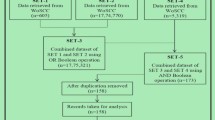Abstract
This article examines the media reportage of white-collar crimes, organised crimes and cybercrimes, principally in the British but also in the US media. It illustrates the ways in which different newspapers depict crime seriousness and how some defendants adapt to these portrayals. It examines competing explanatory models and suggests that although reportage has an ideological component, ‘news values’ and production pressures as well as ‘action triggers’ such as prosecutions or regulatory interventions are important.
Similar content being viewed by others
Notes
As Martha Stewart expressed it 2 years after her release (and note the typical circumlocutory language that evades real liability for perverting the course of justice after allegations of insider trading):
Speaking to Life magazine, Stewart says: “When I say I really don’t know what I was accused of, I mean that. It was a very difficult time in American business. The clamping down on business behaviour, the intense scrutiny on very visible figures in America—I was one of them, because I was the first woman to make a billion dollars in America. So I sold some stock, and I was accused of doing something around that sale that really didn’t make too much sense, and I had to go to jail because I defended myself.”
Her survival is nicely expressed in the following gushing quote from New York Magazine in 2007 (http://nymag.com/homedesign/fall2007/39604/):
“Daunted” is not in Stewart’s vocabulary, nor is “tired.” After serving her 5-month jail sentence for obstruction of justice, her stock plummeted. In a rare misstep, her version of The Apprentice didn’t take. But no matter. Currently, her magazines are briskly gaining ad pages, and her NBC daytime show is a hit, with celebrities like Russell Crowe and Valentino as guests. And she comes home to this 150-acre Bedford estate, with its myriad outbuildings, including a huge greenhouse and stone stables that should make new neighbor Ralph Lauren jealous, and a host of employees (the newest is her personal French chef, Pierre Schaedelin). Stewart is furiously launching, launching, launching.
Though on the ‘upside’, most Arthur Andersen partners and employees found lucrative alternative employment with the other large accounting firms, who ‘reluctantly’ soaked up the business from the corporations who felt that they needed to be audited by ‘Big Four’ firms.
Without becoming too Foucauldian, the symbolism of the prisoner in the dock is an important part of distancing the accused from ‘us’. However the specialist courts with computer screens for electronic documentation and satellite technology for remote interrogations in the big London cases have done away with the dock, so the accused sit with their lawyers rather than being in a special place of stigma.
According to The Guardian (30 March 2007), of the TK Maxx details stolen in both Britain and America, 30.6 m came from cards which had expired at the time of the breach, while 15 m were unexpired. Of those still valid, 3.8m had “masked” or encrypted information but 11.2 m had clearly accessible data.
This author’s attempt to interest them in this fact was ignored.
References
Barlow, M., Barlow, D., & Chiricos, T. (1995). Economic conditions and ideologies of crime in the media. Crime & Delinquency, 41(1), 3–19.
Chibnall, S. (1977). Law and Order News. London: Tavistock.
Cohen, S. (2002). Folk Devils and Moral Panics, 3rd ed. London: Routledge.
Hall, S., Critcher, C., Jefferson, T., Clarke, C., & Roberts, B. (1978). Policing the Crisis: Mugging, the State and Law and Order. London: Macmillan.
Innes, M. (2004). ‘Signal crimes and signal disorders: notes on deviance as communicative action’. The British Journal of Sociology, 55(3), 335–355.
Levi, M. (2007). Organised crime and terrorism. In M. Maguire, R. Morgan, & R. Reiner (Eds.) The Oxford Handbook of Criminology 4th Edition. Oxford: Oxford University Press.
Levi, M. (2008). The Phantom Capitalists: the Organisation and Control of Long-Firm Fraud, 2nd edition. Andover: Ashgate.
Stephenson-Burton, A. (1996). Through the looking-glass: Public images of white-collar crime. In D. Kidd-Hewitt, & R. Osborne (Eds.) Crime and the Media: The Post-Modern Spectacle. London: Pluto Press.
Sterling, B. (1993). The Hacker Crackdown. London: Viking.
Wolfe, T. (1987). Bonfire of the Vanities. London: Paladin.
Author information
Authors and Affiliations
Corresponding author
Rights and permissions
About this article
Cite this article
Levi, M. White-collar, organised and cyber crimes in the media: some contrasts and similarities. Crime Law Soc Change 49, 365–377 (2008). https://doi.org/10.1007/s10611-008-9111-y
Published:
Issue Date:
DOI: https://doi.org/10.1007/s10611-008-9111-y




